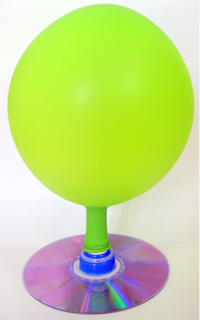Hovercraft: A Multi-Terrain Vehicle
Planes, trains, and automobiles... all great ways to get around. But when it comes to exploring cool travel, the hovercraft shines with its ability to effortlessly glide across land or water. Make one at home to explore the aerodynamics at work!

If you get some great in-air photos, please share them with us. We would love to see your family science hovercraft exploration!
Touted as an environmentally friendly design—it travels mostly above the surface—hovercraft are often associated with water, in part because they have become linked with rescue vehicles. While they are amphibious, hovercraft are not limited to water. Instead, hovercraft are multi-terrain vehicles. The DiscoverHover website describes them as "boat-like vehicles, but they are much more than just a boat, because they can travel over not only water, but grass, ice, mud, sand, snow and swamp as well." The craft's ability to ride on a self-generated and self-maintained cushion of air as it transitions between different terrain is at the heart of the vehicle's innovative aerodynamic design. When hovering, the hull of the craft, which can also float, is lifted off the surface and propelled by a cushion of air that is trapped under the vehicle by a structural "skirt" element.
DIY Hovercraft
Exploring aeronautics principles and design issues related to hovercraft doesn't require a factory, heavy machinery, power tools, or a sophisticated motor. You don't even need wheels! Using materials you probably have around the house, your students can park the die-cast cars for the day and embark on an afternoon's worth of hovercraft racing with their own balloon-powered vehicles.
The simplest hovercraft model can be constructed from a paper plate and a balloon. This model offers a hands-on look at how the craft moves, but repeated travels will probably put a dent in the design. Using foam board instead of a paper plate may increase the longevity of the model. Though thicker than a paper plate, foam board is sturdier and yet still lightweight, an important factor in DIY hovercraft success. If you have a sheet of Elmer's foam board tucked away in a craft closet, your young engineers can experiment with the shape of the craft. Does a circular hovercraft fly farther than a rectangular one? What diameter of circle works best? What is the relationship between the size of the circle and the size of the balloon? Does a foam board hovercraft fly as far as one made from a paper plate? What kinds of modifications can you make to the center where the balloon is stationed?
Recycled compact discs can also be used to make hovercrafts. Pass over a few old CDs, an equal number of drinking bottle valves, some glue, and a pile of balloons in varying sizes, and let your young engineers loose! If you're ready for the races to begin, the "How Does a Hovercraft Work?" project has the blueprint for designing your own miniature hovercraft. You can find additional family-friendly guidance in the CD Hovercraft cartoon from Howtoons. Figuring out what makes the craft hover longer or cover more ground is part of the fun—and part of the science exploration! Make sure to have the video camera ready for some short film footage, just in case there's a finish that's too close to call!
Going Bigger
While building and testing miniature hovercrafts is a great summer activity, especially for elementary (and younger) students, more industrious models are certainly possible and can be excellent under-cover summer projects, perfect for tinkering in the garage. The "Riding on Air—Build a Real Hovercraft" project outlines one approach to creating a leaf-blower powered hovercraft. As part of your background reading, tune in to the DragonFly episode in which Rachel and Sara build their own hovercraft—and troubleshoot problems they encounter on grass. To see another life-size example, check out this video from Howtoons' Saul Griffith.
How well will your hovercraft glide? Put it to the test!
Categories:
You Might Also Enjoy These Related Posts:
- 15 STEM Gifts & Science Kits You'll Feel Good About Giving
- 13 Boat Science and Submarine Science Projects and Experiments
- July 4th STEM! Summer Science Picks for Independence Day!
- 12 Science Kits for Summer Science Experiments and Discovery
- 15 Science Projects to Make and Give for Father's Day
- Ready, Set, Go! (Awesome Summer Science Experiments)
- Awesome Summer Science Experiments
- 10 STEM Activities with Cardboard Tubes









